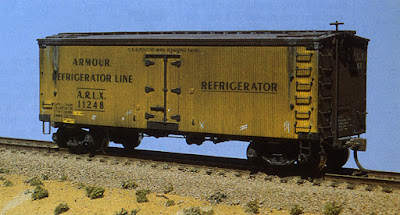I recently received an interesting and challenging comment via email about the context of my recent series of posts about modifying a Rivarossi observation car as a stand-in for a Southern Pacific business car, SP 119, assigned as the Superintendent’s car for SP’s Coast Division during the era I model (1953). I made it clear that I was only modeling the prototype car in broad brush strokes. You can read the concluding post at this link: https://modelingthesp.blogspot.com/2024/08/operating-sp-business-car-conclusion.html .
The remark that came to me was about my “slackened” standards in doing such modeling. This really brings up a far more general topic, about model building in general, and what is the purpose of the models we build. That’s what I comment on in the present post.
Like most if not all modelers, I certainly build occasional models with the intent of stretching my skills to their limit, and getting all major and many minor details exactly right. Usually these are models of Southern Pacific equipment, the prototype I model. An example would be my project to model an automobile car of SP Class A-50-17 (for a description, see: https://modelingthesp.blogspot.com/2015/01/modeling-sp-class-50-17-conclusion.html ). Here’s a photo:
Other times I only want a representation of a prototype, and I often refer to such models as “main line” models, meaning you will only see them on my layout in a passing train on the main line. The business car referred to above is definitely in that category. Freight cars of some railroads that I don’t find very interesting may also be built as “main line” cars.
Even cars of that kind are worth weathering well and making sure that the most obvious parts of the model, notably the roof, would withstand at least a somewhat close-up view. Then they look good even in a passing train.
I am always surprised when I visit a layout and see rolling stock with little or no weathering. You may not wish to weather as thoroughly as my late friend Richard Hendrickson often did, but this can certainly raise the credibility level of even a simple model. Here’s one of Richard’s meat refrigerator car models.
Most of my models, however, are much more accurate than the “main line” cars and will withstand scrutiny from a fairly close viewpoint, as in switching moves near the layout aisle. This especially applies to freight cars of the SP and of Pacific Fruit Express. Are these and the main-line kind of models in conflict? I don’t think so.
I suppose the extreme case is the contest model (or a model built to standards that would allow it to perform well in a major contest). I was an NMRA contest modeler for a number of years, and then graduated to contest judging for both regional and national contests, and finished that phase of my modeling career by serving five years as Contest Chair for NMRA’s Pacific Coast Region. I think it was valuable for me to learn the kind of research, discipline and application needed to succeed with this kind of modeling.
Still, I well remember chatting in a contest room with a group of contestants and judges, and one of the contestants mentioned that he was starting to build a layout. One of the others immediately remarked, “So I guess we won’t be seeing you in the contest room any more.” This encapsulates the choice most of us have to make, between building exquisite individual models, and creating, scenicking and operating a layout.
Where I come down on that choice is quite obvious from many posts in this blog, about numerous topics having to do with my layout, and frankly, equally so for my description of models like the business car, SP 119. Such choices are, after all, to some extent purely practical ones in terms of available time and effort.
I will continue to devote varying amounts of effort to different models. That doesn’t mean “anything goes;” on the contrary, I have long had a self-defined “floor” under quality (see for example my posts about standards; here is one example: https://modelingthesp.blogspot.com/2023/07/standards-for-layout-freight-cars.html ). Final results will always depend on personal choices.
Tony Thompson


Thanks, Tony, for airing this very important issue. From "above the parapet" where I've now been for a few years, I couldn't agree more, about the difference in individual-item, "prototype modelling" to the compromises involved in building an operational and reliable whole model railroad that tries to emulate the prototype (where one may well run a few of one's previous "competition winners" one built when one was not building a whole railroad).
ReplyDeleteAnd the budget limitations are exponential too. Through fiscal necessity, my "Overnight" trains consist mostly of re-sprayed and re-decalled Athearn blue-box boxcars. The three "really accurate" Rapido cars I recently added, came to a total of nearly £200 by the time they reached me in Plymouth, UK; they cost far more than the rest of the "near-enough" train put together.
And don't even get me started on the compromises of my Coast Mail. I'll never be able to afford the brass, but it looks OK to me, and runs reliably. It sounds daft, but you really do need to learn to compromise to be a "prototype" layout modeller.
Thanks for extending my comments a bit further, Brian. We are certainly on the same page on this issue.
DeleteI sometimes remind people that for many years, Model Railroader magazine had a very prominent slogan on every cover: Model Railroading is Fun. It's still there, but much smaller today. Doesn't make it less true.
Tony Thompson